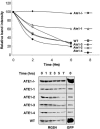Identification of mammalian arginyltransferases that modify a specific subset of protein substrates
- PMID: 16002466
- PMCID: PMC1173364
- DOI: 10.1073/pnas.0504500102
Identification of mammalian arginyltransferases that modify a specific subset of protein substrates
Abstract
Posttranslational N-terminal protein arginylation, mediated by Arg-tRNA-protein transferase 1 (ATE1), is essential for cardiovascular development and angiogenesis in mammals but is nonessential in yeast. Evidence suggests that many proteins are arginylated in vivo in both mammals and yeast; however, in yeast, N-terminal arginylation can occur only on proteins bearing an N-terminal Asp or Glu, whereas in mammals, N-terminal Cys residues are also arginylation targets, suggesting that Cys arginylation contributes to the essential role of ATE1 in mammals. To date, all of the characterized forms of ATE1 in yeast and mammals have been shown to arginylate only Asp and Glu, leaving open to speculation whether Cys arginylation is possible only through other components of mammalian arginylation machinery and whether Cys-specific forms of Arg-transferase exist in mammals. Here, we report the identification of two forms of Arg-transferase in mice that are specific for N-terminal Cys. We also show that the two previously identified mammalian forms of ATE1 can arginylate Cys-containing substrates in addition to Asp- and Glu-containing substrates. This finding provides insights into the significance of Cys-specific protein arginylation in mammals and suggests possibilities of the determinants of substrate specificity within the ATE1 molecule.
Figures




References
-
- Kaji, A., Kaji, H. & Novelli, G. D. (1963) Biochem. Biophys. Res. Commun. 10, 406-409. - PubMed
-
- Balzi, E., Choder, M., Chen, W. N., Varshavsky, A. & Goffeau, A. (1990) J. Biol. Chem. 265, 7464-7471. - PubMed
-
- Kaji, H. (1968) Biochemistry 7, 3844-3850. - PubMed
-
- Soffer, R. L. (1973) J. Biol. Chem. 248, 2918-2921. - PubMed
-
- Li, J. & Pickart, C. M. (1995) Biochemistry 34, 15829-15837. - PubMed
Publication types
MeSH terms
Substances
Associated data
- Actions
- Actions
LinkOut - more resources
Full Text Sources
Other Literature Sources
Molecular Biology Databases

